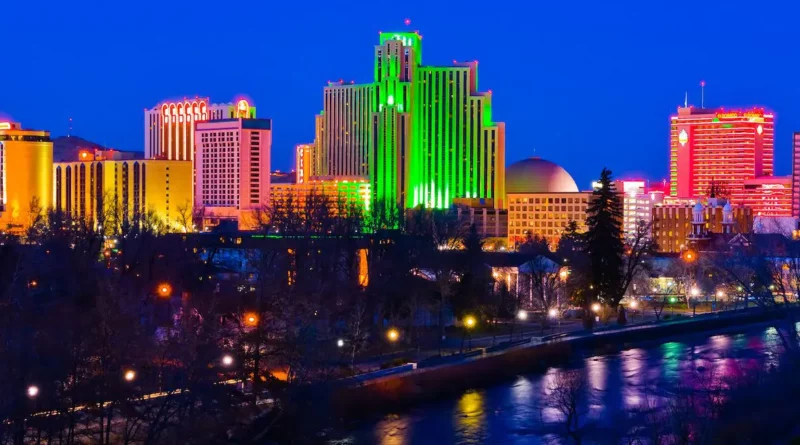History of Reno Nevada
Reno, Nevada, is a city with a rich and multifaceted history that mirrors the broader story of the American West. Known as “The Biggest Little City in the World,” Reno has played a pivotal role in various phases of the United States’ development, from its early days as a frontier town to its status as a major center for gambling, tourism, and education. This article delves into the history of Reno, exploring how it evolved from a small settlement on the banks of the Truckee River to a vibrant, modern city with a diverse cultural and economic landscape.
Early Beginnings
Before European settlers arrived, the area that would become Reno was home to indigenous peoples, primarily the Washoe tribe. The Washoe inhabited the region around the Truckee River and Lake Tahoe for thousands of years, relying on the abundant natural resources for sustenance. The arrival of European explorers in the early 19th century marked the beginning of significant changes for the native populations. The fur trade, followed by the discovery of precious metals, brought more settlers into the area, leading to increased conflicts and displacement of the indigenous peoples.
The mid-1800s saw the first waves of European-American settlers drawn to the region by the promise of riches. The discovery of gold in California in 1848, followed by the Comstock Lode silver strike in Virginia City in 1859, spurred a mass migration through the Nevada Territory. While Reno itself did not emerge as a major mining town, its proximity to these booming areas would later influence its development as a key transportation hub.
The Founding of Reno
Reno’s official founding is closely tied to the expansion of the Central Pacific Railroad, which played a critical role in the development of the American West. The town was officially established in 1868 when the Central Pacific Railroad, as part of the First Transcontinental Railroad, reached the area. Myron Lake, a local entrepreneur, saw the potential in this location and persuaded railroad officials to build a station on his land. In return, he promised to build a bridge over the Truckee River, which would be crucial for travelers and traders alike. The town was named “Reno” in honor of Union Major General Jesse Lee Reno, a hero of the American Civil War.
The arrival of the railroad transformed Reno from a small settlement into a bustling town. The railroad made Reno a critical junction, connecting the mining districts of northern Nevada with the rest of the country. This connection facilitated the transportation of goods and people, laying the foundation for Reno’s future growth.
The Railroad Era
The Central Pacific Railroad’s influence on Reno cannot be overstated. It not only spurred the initial growth of the town but also established Reno as a key point of access to the remote and often isolated mining communities throughout Nevada. The railroad brought with it a surge of new residents, businesses, and services, transforming Reno into a lively commercial center almost overnight.
In addition to serving the mining industry, the railroad also connected Reno to major cities like San Francisco and Salt Lake City. This connectivity helped Reno develop a diverse economy, including agriculture, ranching, and trade. By the late 19th century, Reno was well on its way to becoming one of the most important cities in Nevada.
The Boomtown Years
The late 19th and early 20th centuries were a time of rapid growth and change for Reno. The city’s population expanded as more settlers arrived, drawn by the economic opportunities created by the railroad and the nearby mining operations. However, unlike other Nevada towns that were solely dependent on mining, Reno’s economy was more diversified, with agriculture, livestock, and trade playing significant roles.
During this period, Reno began to develop a reputation as a place of opportunity, where fortunes could be made. This boom period also saw the establishment of some of the city’s earliest institutions, including schools, churches, and civic organizations. These institutions helped to create a sense of community and stability in what was still a relatively new and rough frontier town.
The Divorce Capital of the World
One of the most unique and surprising chapters in Reno’s history is its period as the “Divorce Capital of the World.” In the early 20th century, Reno became famous for its liberal divorce laws, which allowed people to obtain a divorce after only six weeks of residency in Nevada. This was a stark contrast to the more restrictive divorce laws in other states, where obtaining a divorce could be a lengthy and expensive process.
Reno’s divorce industry began to flourish in the 1910s and 1920s, attracting wealthy and famous individuals from across the country who sought quick and discreet divorces. The influx of divorce-seekers boosted Reno’s economy, leading to the growth of hotels, restaurants, and legal services catering to this clientele. This period also helped shape Reno’s image as a place of freedom and new beginnings, an identity that would continue to influence the city’s development in the decades to come.
The Rise of Gambling
While Reno’s reputation as a divorce haven was unique, its status as a gambling mecca would become even more defining. Gambling had always been a part of Nevada’s history, but it was formally legalized in 1931 as a way to help the state recover from the economic hardships of the Great Depression. Reno quickly embraced this new opportunity, and the city soon became synonymous with casinos and entertainment.
The legalization of gambling led to the rapid expansion of Reno’s casino industry. Iconic establishments like the Bank Club and Harrah’s opened their doors, attracting visitors from all over the country. The revenue generated from gambling allowed Reno to invest in infrastructure, tourism, and public services, solidifying its place as a premier destination in the American West.
Reno’s Role During World War II
World War II had a significant impact on Reno, as it did on the entire nation. The city’s strategic location and existing infrastructure made it an ideal site for military installations. Reno became home to several important military facilities, including the Reno Army Air Base (now Reno-Stead Airport), which was used for training pilots and aircrews.
The war effort also brought economic benefits to Reno, as the demand for goods and services increased. The influx of military personnel and defense workers boosted the local economy and led to further expansion of the city. However, the end of the war also brought challenges, as Reno had to transition from a wartime economy back to peacetime conditions.
Post-War Expansion
The post-war years were a period of significant growth and development for Reno. The city’s population expanded rapidly as returning soldiers and their families moved to the area, attracted by the opportunities in Reno’s booming economy. The tourism industry, fueled by the continued success of the casino industry, played a major role in this growth.
Reno’s entertainment industry also began to diversify during this time, with the introduction of new attractions and events designed to draw visitors from across the country. The construction of new hotels, theaters, and convention centers helped to solidify Reno’s reputation as a destination for both leisure and business travelers.
Cultural and Demographic Shifts
As Reno grew, it also became more diverse. The post-war era saw an influx of migrants from various parts of the United States and abroad, bringing with them different cultures, traditions, and perspectives. This diversity enriched Reno’s cultural landscape, leading to the establishment of new cultural institutions, festivals, and community organizations.
The Civil Rights Movement of the 1960s also had an impact on Reno, as the city grappled with issues of segregation, discrimination, and social justice. The push for civil rights led to greater awareness and efforts to address inequalities within the community. This period also saw the growth of Reno’s Hispanic and African American communities, who contributed to the city’s cultural and economic development.
Urban Development and Modernization
The latter half of the 20th century was a time of significant urban development and modernization in Reno. As the city continued to grow, new residential neighborhoods, shopping centers, and industrial parks were built to accommodate the expanding population. The construction of the Interstate 80 and U.S. Route 395 highways further enhanced Reno’s connectivity, making it easier for people and goods to move in and out of the city.
However, this period also brought challenges, particularly in the form of urban sprawl and the decline of Reno’s downtown area. As more people moved to the suburbs, downtown Reno experienced a decrease in foot traffic and economic activity. This led to the closure of some businesses and the deterioration of historic buildings, prompting concerns about the city’s future.
The Decline and Revitalization of Downtown Reno
By the late 20th century, downtown Reno was facing significant challenges. The rise of larger, more glamorous casinos in Las Vegas had drawn some of Reno’s tourism away, and the city’s downtown area was struggling with issues of blight, crime, and economic decline. However, the community and local government recognized the importance of revitalizing downtown Reno and began taking steps to reverse these trends.
Efforts to revitalize downtown Reno have included the renovation of historic buildings, the creation of new public spaces, and the development of new attractions designed to draw both locals and tourists back to the area. The construction of the Truckee Riverwalk, the opening of new restaurants and shops, and the development of cultural events like the Reno Artown festival have all contributed to the resurgence of downtown Reno as a vibrant and attractive destination.
Reno’s Educational and Cultural Institutions
Education and culture have always been important aspects of Reno’s identity. The University of Nevada, Reno (UNR), established in 1874, is one of the oldest institutions of higher education in the state and has played a crucial role in the city’s development. UNR has grown significantly over the years, expanding its academic programs, research initiatives, and student population. The university is also a major cultural hub, hosting various events, performances, and exhibitions that contribute to Reno’s cultural vibrancy.
In addition to UNR, Reno is home to several museums, theaters, and cultural centers that reflect the city’s diverse heritage. The Nevada Museum of Art, the National Automobile Museum, and the Pioneer Center for the Performing Arts are just a few examples of the institutions that make Reno a center for culture and learning in the region.
Reno in the 21st Century
The 21st century has brought new challenges and opportunities for Reno. The rise of technology and the shift towards a knowledge-based economy have led to changes in the city’s economic landscape. Reno has increasingly attracted tech companies and startups, leading to the growth of new industries and the creation of high-paying jobs. Companies like Tesla, Google, and Amazon have established significant operations in the area, transforming Reno into a tech hub.
This economic transformation has also led to changes in Reno’s demographics, as new residents move to the city in search of employment and a high quality of life. While this growth has brought economic benefits, it has also created challenges, including rising housing costs and increased demand for public services. Nonetheless, Reno’s resilience and adaptability have allowed it to navigate these changes and continue to thrive in the modern era.
Environmental Challenges and Initiatives
As Reno has grown, it has also had to confront various environmental challenges. The city’s location in a high desert region means that water resources are limited, and managing this precious resource has been a constant concern. Climate change has further exacerbated these challenges, with increasing temperatures and changing precipitation patterns affecting the region.
In response to these challenges, Reno has taken steps to promote sustainability and environmental stewardship. The city has invested in renewable energy projects, water conservation programs, and efforts to reduce greenhouse gas emissions. These initiatives are part of a broader commitment to ensuring that Reno remains a livable and vibrant city for future generations.
Conclusion
Reno, Nevada, has a history as diverse and dynamic as the American West itself. From its origins as a small settlement on the banks of the Truckee River to its emergence as a major hub for gambling, tourism, and technology, Reno has continuously reinvented itself in response to changing times and circumstances. Today, Reno stands as a testament to the enduring spirit of innovation, resilience, and community that has defined its journey from a frontier town to a modern, thriving city.
FAQs
1. What was the original name of Reno?
Reno was named after Union Major General Jesse Lee Reno, but before its official founding, the area was simply referred to as Lake’s Crossing, after Myron Lake, who owned a toll bridge and other facilities in the area.
2. Why was Reno called the “Divorce Capital of the World”?
Reno earned this nickname in the early 20th century due to Nevada’s liberal divorce laws, which allowed individuals to obtain a divorce after only six weeks of residency, attracting people from across the country seeking quick divorces.
3. How did gambling become central to Reno’s identity?
Gambling was legalized in Nevada in 1931 as a way to boost the state’s economy during the Great Depression. Reno quickly embraced gambling, and its casinos became a major draw for tourists, helping to shape the city’s identity.
4. What are some of the key cultural institutions in Reno?
Reno is home to several important cultural institutions, including the University of Nevada, Reno, the Nevada Museum of Art, the National Automobile Museum, and the Pioneer Center for the Performing Arts.
5. How did the railroad influence Reno’s development?
The Central Pacific Railroad was instrumental in Reno’s growth, establishing the town as a key transportation hub and connecting it to major cities and mining districts, which facilitated trade and the movement of people.
6. What efforts have been made to revitalize downtown Reno?
Efforts to revitalize downtown Reno have included the renovation of historic buildings, the creation of new public spaces like the Truckee Riverwalk, and the development of cultural events and attractions to draw both locals and tourists to the area.
Discover more from City Towner
Subscribe to get the latest posts sent to your email.




